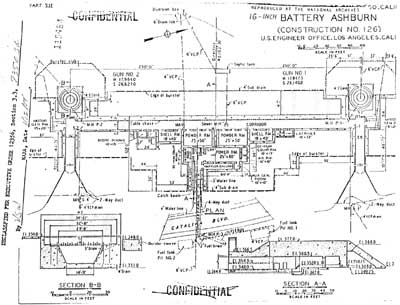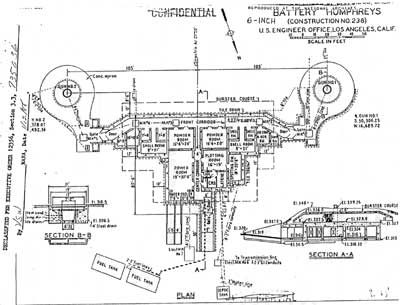|
CABRILLO
The Guns of San Diego Historic Resource Study |

|
CHAPTER 7:
WORLD WAR II AND AFTER, 1941-1948
On the first anniversary of the Japanese attack on Pearl Harbor, Fort Rosecrans' newspaper, Cannon Report, asked its readers, "Where Were You on Dec. 7th?" It replied to its own question:
Ft. Rosecrans was a hotbed of excitement. Furloughs were literally snatched away from men as they were leaving the gate. Soldiers out on passes rushed back as they never rushed before. Five men reported a Japanese submarine off Point Loma. Cpl. Don Whitehead, then on duty at headquarters, reflects: "The mass of telegrams, telephone calls and messages to man the guns gave me the most thrilling experiences yet. A day I'll never forget." [1]
When Japanese planes bombed Oahu, the Harbor Defenses of San Diego went on full alert. Troops moved to the gun positions immediately. Soldiers hauled ammunition to the coastal guns. Machine guns were set up. Guards prohibited citizens from entering the reservation, thus isolating Cabrillo National Monument. Batteries H and I, 19th Coast Artillery, set up 30 caliber machine guns for the antiaircraft protection of the Consolidated Aircraft Company. The Harbor Defense Command Post and the Harbor Entrance Control Post were manned immediately and continuously until the end of the war. Battery Point Loma replaced Battery McGrath as the alert/examination battery. [2]
A. Battery Ashburn
In November 1941, the Chief of Engineers received funds for the construction of a 16-inch gun battery at Fort Rosecrans. These two guns, the largest type in the harbor defenses of the United States, were the only ones in San Diego's defenses to be casemated. Known first as Battery Construction No. 126, it was named in honor of Maj. Gen. Thomas Quinn Ashburn, who graduated from West Point in 1897 and began his army career in the Artillery. He won a Silver Star in the Philippines and a Purple Heart in France. General Ashburn died in 1941.
The Macco Construction Company began work on the battery in June 1942 and completed it in March 1944 at a cost of $1,324,000. The guns were proof-fired in July, but the gun shields did not arrive until early 1945. The data concerning the guns and the barbette carriages were as follows:
| Guns | Caliber | Length | Model | Ser. No. | Manufacturer | Mounted |
| 1 | 16-inch | 816 in. | I | 71 | Bethlehem Steel | March 1944 |
| 2 | 16-inch | 816 in. | Mark II Model I | 97 | Watervliet Arsenal | March 1944 |
| Carriage Type | Model | Ser. No. | Manufacturer |
| 1 barbette | M-4 | 31 | Wellman Engineering Company |
| 2 barbette | M-4 | 39 | Watertown Arsenal |
Battery Ashburn served through the rest of the war but was declared surplus in May 1948, with the advent of atomic bombs and missiles. [3] Ashburn's plotting and switchboard room (PSR) was built as a large underground concrete structure to the north and east across the road from the battery.

|
| One of Battery Ashburn's two 16-inch guns. This photo must have been taken after World War II. The army would not have allowed such a picture during the war. Courtesy, historic photo collection, Cabrillo National Monument. |

|
| Battery 134, currently located near Navy antennae field, Imperial Beach and called Battery 99. The proposed name was Battery Gatchell. Work project was canceled in 1944, the 16-inch guns never installed. Photo courtesy of U.S. Navy. |
B. Battery Humphreys
Work began on the first of three 6-inch batteries, Construction No. 238, later named Humphreys, in February 1942. V. R. Dennis of San Diego won the contract in the amount of $128,000 (actual cost, $200,000). Located on top of Point Loma above the new lighthouse, it was named in honor of Capt. Charles Humphreys, Fort Rosecrans' first commanding officer. The engineers considered the battery completed on October 14, 1943. A completion report recorded the guns and carriages thus:
| Guns | Caliber | Model | Ser. No. | Manufacturer |
| 1 | 6-inch | M1903A2 | 1 | Watervliet Arsenal |
| 2 | 6-inch | M1903A2 | 101 | Watervliet Arsenal |
| Carriages | Type | ]Model | Ser. No. | Manufacturer |
| 1 | barbette | barbette | 101 | Wellman Engineering Company |
| 2 | barbette | barbette | 100 | Wellman Engineering Company |
C. Batteries Gillespie and Zeilin
Before the attack on Pearl Harbor, the Army allowed the Marines to emplace two gun batteries in northwest Fort Rosecrans for training purposes:
Battery Gillespie, three 5-inch navy guns, and Battery Zeilin, two 7-inch navy guns. Both batteries were named for Marine Corps officers who took part in the American conquest of California: Lt. Archibald H. Gillespie, who came to Kearny's assistance following the Battle of San Pasqual, and Lt. Jacob Zeilin who later became commandant of the Corps. Soon after December 7, the Marines turned both batteries over to the Army and soldiers manned them on a twenty-four hour basis. Col. Ottosen expected to keep the guns as long as the Marines did not require them. The colonel reported that Battery Gillespie, along with Battery Point Loma, had an antisubmarine mission. [5] A 155mm battery was manned by HDSD troops for several months after the beginning of the war at Camp Callan Coast Artillery Replacement Training Center south of Torrey Pines State Park.
| <<< Previous | <<< Contents >>> | Next >>> |
cabr/guns-san-diego/hrs7.htm
Last Updated: 19-Jan-2005

